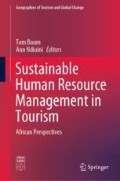Abstract
This paper examines the contribution of missionaries’ guesthouses in West Pokot County, Kenya to human resource development especially on imparting necessary hospitality skills through on-the-job training. Tourism skill deficiency is the main challenge confronting these areas in their quest to harness their tourism development potentialities yet by its nature as a highly service-orientated industry, the tourism sector relies on human resources with the requisite skills so as to offer the services that meet the expectation of the tourists and hence satisfy them. However, despite lacking these skills most of these rural areas are turning to tourism as a strategy for socio-economic development. The rate at which tourism is expanding to rural areas and rural communities in Kenya is not commensurate to the number of skillful human resources available in the same areas. This is the main challenge that this study seeks to solve. This study therefore sought to examine the role of missionaries’ guesthouses in rural parts of Kenya in training human resources for the tourism sector in the region. Specifically the study focused on the nature and place of informally acquired tourist skills at the missionaries’ guesthouses in West Pokot County, Kenya
Access this chapter
Tax calculation will be finalised at checkout
Purchases are for personal use only
References
Aronsson, L. (2000). The development of sustainable tourism. London: Continuum.
Asker, S., Boronyak, L., Carrard N., & Paddon, M. (2010). Effective community based tourism. Institute for Sustainable Futures, University of Technology Sydney.
Bhuiyan, M. A. H., Siwar, C., Ismail, S. M., & Islam, R. (2011). The role of government in ecotourism development: Focusing on east coast economic regions. Journal of Social Sciences, 7, 557–564. https://doi.org/10.3844/jssp.2011.557.564.
Bhuiyan, M. A. H., Siwar, C., Ismail, S. M., & Islam, R. (2012). Home stay accommodation for tourism development in east coast economic region. American Journal of Applied Sciences, 9(7), 1085–1090.
Bhuiyan, H. A., Siwar, C., & Ismail, M. S. (2013). Socio-economic impacts of home stay accommodations in Malaysia: A study on home stay operators in Terengganu state. Asian Social Science, 9(3).
Callon, M., Miles, Y., & Muniesa, F. (2007). Market devices. Oxford: Blackwell Publishers.
Cooper, C., Fletcher, J., Gilbert, D., & Wanhill, S. (1998). Tourism principles and practice (2nd ed.). Harlow: Pearson.
County Government of West Pokot. (2014). County intergrated developemnt plan (2013–2017). Kapenguria, Kenya.
George, R. (2012). Managing tourism in South Africa. Cape Town: Oxford University Press Southern Africa (Pty) Ltd.
GoK. (2007). Vision 2030 document. Government Press.
Government of Kenya. (2014). Report of the commission of revenue allocation. Nairobi, Kenya.
Hagan, J., Demonsant, J. L, & Chávez, S. (2014). Identifying and measuring the lifelong human capital of “Unskilled” migrants in the Mexico-US migratory circuit. Journal of Migration and Human Security (JMHS), 2(2), 76–100.
Henning, R. (2004). Effective guesthouse management (2nd ed.). Cape Town: Juta.
Jacobs, P., & Makaudze, E. (2012). Understanding rural livelihoods in the West Coast District, South Africa. Development Southern Africa, 29(4), 574–587.
Keyser, H. (2009). Developing tourism: Towards competitive destinations. Oxford University Press.
KNBS. (2018). Economic survey, 2017. GoK.
Lyon, S. (2013). Coffee tourism and community development in Guatemala. Human Organization, 72(3), 188–198.
Manyara, G., & Jones, E. (2010). Community-based tourism enterprises development in Kenya An exploration of their potential as avenues of poverty alleviation. Journal of Sustainable Tourism, 15, 628–644.
Marzuki, A. (2009). A review on public participation in environmental impact assesmement in Malaysia. Journal of Theoretical and Empirical Researches in Urban Managment, 3(12).
Mascardo, G. (2008) (Ed.). Building community for tourism development. London, UK: CAB International.
Milne, S., & Alteljevic, I. (2001). Tourism, economic development and the global-local nexus: Theory embracing complexity. Tourism Geographies, 3(4), 369–393.
Page, J. (2009). Tourism management: Managing for change (3rd ed.). Linacre House, Burlington, Ma 01803. Elsevier Ltd.
Ramukumba, T. (2016). Contribution of guesthouses to local economic development through procurement of locally produced products and services in the Eden District Municipality, South Africa. African Journal of Hospitality, Tourism and Leisure, 5(2).
Ramukumba, T., & Ferreira, I. W (2016). Contribution of guesthouses to local economic development through procurement of locally produced products and services in the Eden District Municipality, South Africa. African Journal of Hospitality, Tourism and Leisure, 5(2). ISSN: 2223-814X.
Samimi, A. J., Sadeghi, S., & Sadeghi, S. (2011). Tourism and economic growth in developing countries: P-VAR approach. Middle-East Journal of Scientific Research, 10(1), 28–32.
Sharpley, R. (2001). Tourism in Cyprus: Challenges and opportunities. Tourism Geographies, 3(1), 64–86. UK: University of Northumbria.
Tasci, D. A., Croes, R., & Jorge, B. V. (2014). Rise and fall of community-based tourism—Facilitators, inhibitors and outcomes. Worldwide Hospitality and Tourism Themes, 6(3), 261–276.
Tosun, C. (2000). Limits to community participation in the tourism development process in developing countries. Tourism Management, 21, 613–633.
UNEP, United Nations Environment Programme, and UNWTO, United Nations World Tourism Organization. (2005). Making tourism more sustainable: A guide for policy makers. Paris and Madrid: UNEP and WTO.
UNWTO. (2016). Tourism highlights. http://www.e-nwto.org/doi/book/10.18111/9789284418145.pfd.
Woodhouse, A. (2006). Social capital and economic development in regional Australia: A case study. Journal of Rural Studies, 22, 83–94.
World Bank. (2010). Kenya’s tourism: Polishing the jewel. May 2010, Nairobi: Finance and Private Sector Development Africa Region, World Bank.
World Economic Forum. (2015). The global competitiveness report 2015–2016.
World Travel and Tourism Council (WTTC). (2017). Travel and tourism economic impact 2017 Kenya.
Author information
Authors and Affiliations
Corresponding author
Editor information
Editors and Affiliations
Rights and permissions
Copyright information
© 2020 Springer Nature Switzerland AG
About this chapter
Cite this chapter
Ng’oriarita, J.P. (2020). Missionaries’ Guesthouses and Skills Development for Community-Based Tourism in West Pokot County, Kenya: A Capacity Building and Employment Analysis. In: Baum, T., Ndiuini, A. (eds) Sustainable Human Resource Management in Tourism. Geographies of Tourism and Global Change. Springer, Cham. https://doi.org/10.1007/978-3-030-41735-2_13
Download citation
DOI: https://doi.org/10.1007/978-3-030-41735-2_13
Published:
Publisher Name: Springer, Cham
Print ISBN: 978-3-030-41734-5
Online ISBN: 978-3-030-41735-2
eBook Packages: Earth and Environmental ScienceEarth and Environmental Science (R0)

